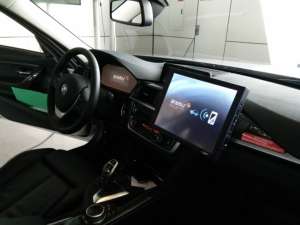Driver information systems, such as the speedometer, navigation system or entertainment applications, might soon be operated reliably using an electronic multi-core processor. Credit: ARAMiS/KIT
Information technologies provide cars and planes with many useful assistance systems and determine product properties. In the future, the necessary computation capacity will be supplied by multi-core processors that will replace the inflexible single-core systems with their limited capacity. As a result, however, programming paradigms will change and safety and reliability will have to be rethought and reviewed for critical applications in particular. The ARAMiS project has now developed demonstrators to show how the new technology can be integrated into safety-critical systems.
"We have to pave the way for future innovations in automotive, avionics, and railway technologies that are so important to Germany, and also in industry 4.0," overall project coordinator Professor Jürgen Becker, KIT, explains. "ARAMiS successfully demonstrates how today's and future multi-core technologies can and have to be used."
"We want our products to continue to be the best in the future," industry coordinator Professor Heinrich Dämbkes, Airbus, adds. "To reach this objective, it is required to transfer latest IT technologies to safe and reliable products for mobility."
The ARAMiS project has produced five demonstrators based on multi-core technology for use in the automotive, avionic, and railway sectors. In a 1 : 1 –scaled model of an aircraft cabin, several servers for e.g. communication, illumination, and displays are combined in a joint cabin management server and new safety concepts are implemented. In addition, a situation awareness radar system is operated with multi-core processors. In a test vehicle, driver information systems, such as a speedometer, the navigation system or entertainment applications, have been integrated successfully in an electronic multi-core processor device. Multi-core technology is also applied in the area of safety-critical real-time applications, such as chassis and engine control. In the railway technology sector, ARAMiS shows how safety-critical applications can be realized by virtualization on multi-core processors.
In this way, the safety-critical applications can now profit from the higher computation capacity of multi-core systems. In addition, it is possible to reduce weight and the space and energy needed in cars, planes, and trains by replacing many control units by a few high-performance multi-core systems. Apart from safety, efficiency and travel comfort are increased. ARAMiS has produced important technical results for the use of multi-core processors in safety-critical systems. Within the framework of future projects, it is now planned to further develop the methods and concepts for wide application by product developers.
The ARAMiS (Automotive Railway and Avionics Multicore Systems) project had a total volume of about EUR 40 million and a duration of three years. Concepts were developed for use of high-performance computer processors with multiple cores in the transportation sector and for enhancing safety, efficiency, and comfort by new functions. So far, single-core processors have been used for safety-relevant functions only, because their functioning could be predicted with the necessary reliability and, hence, certified. However, single-core processors are presently reaching their limits and increasingly disappear from the market.
Provided by Karlsruhe Institute of Technology





















